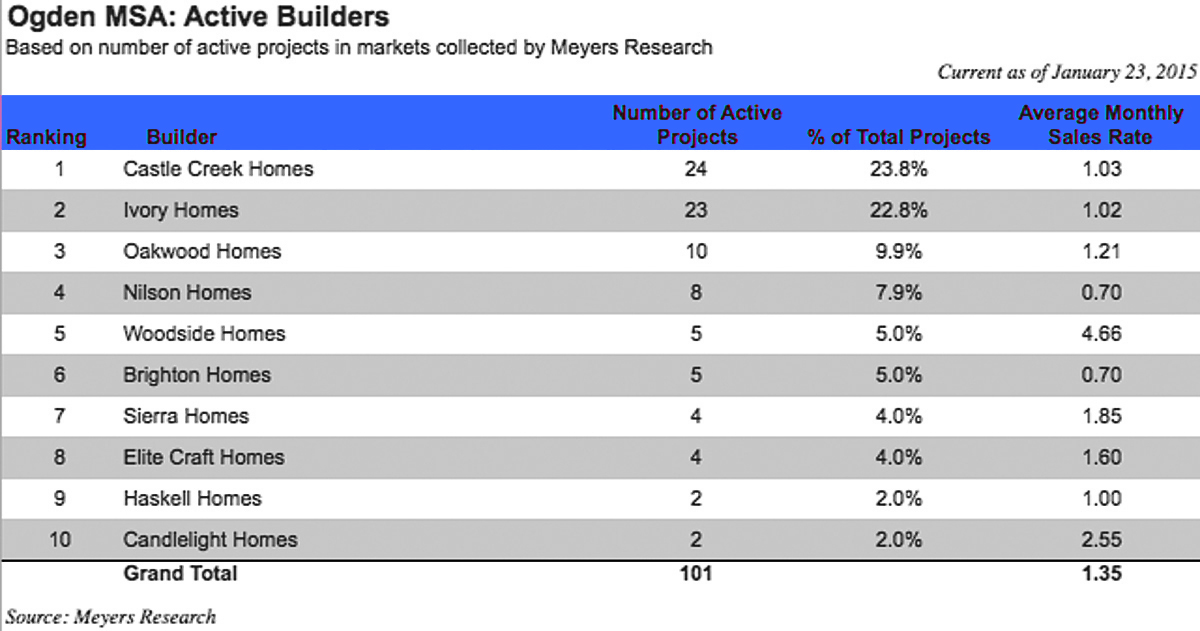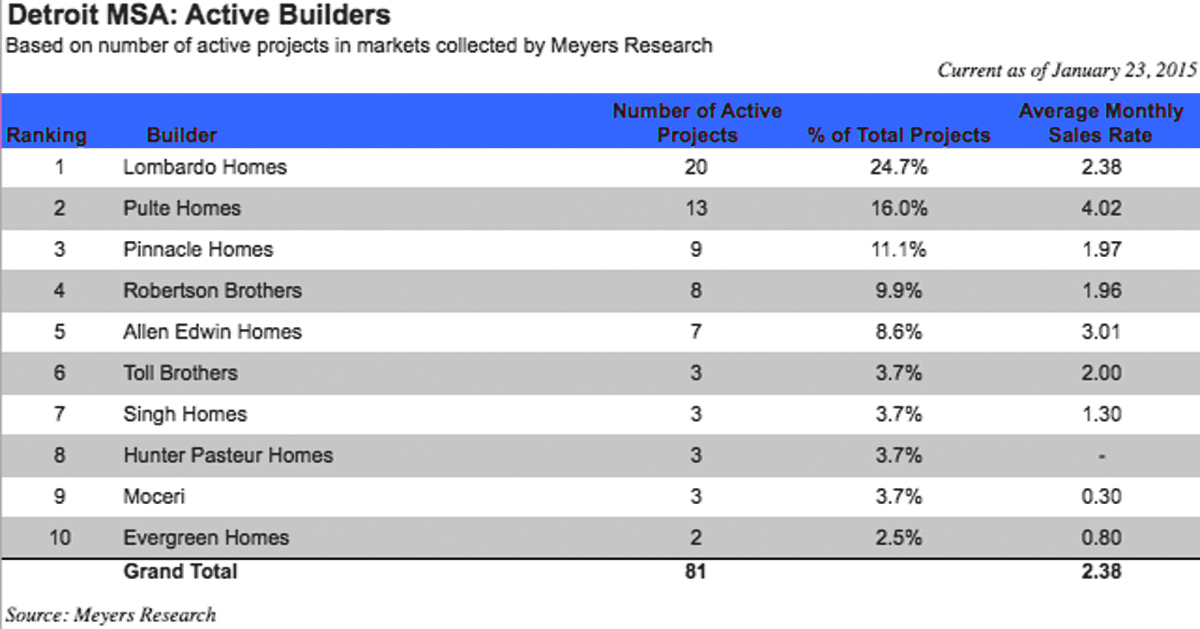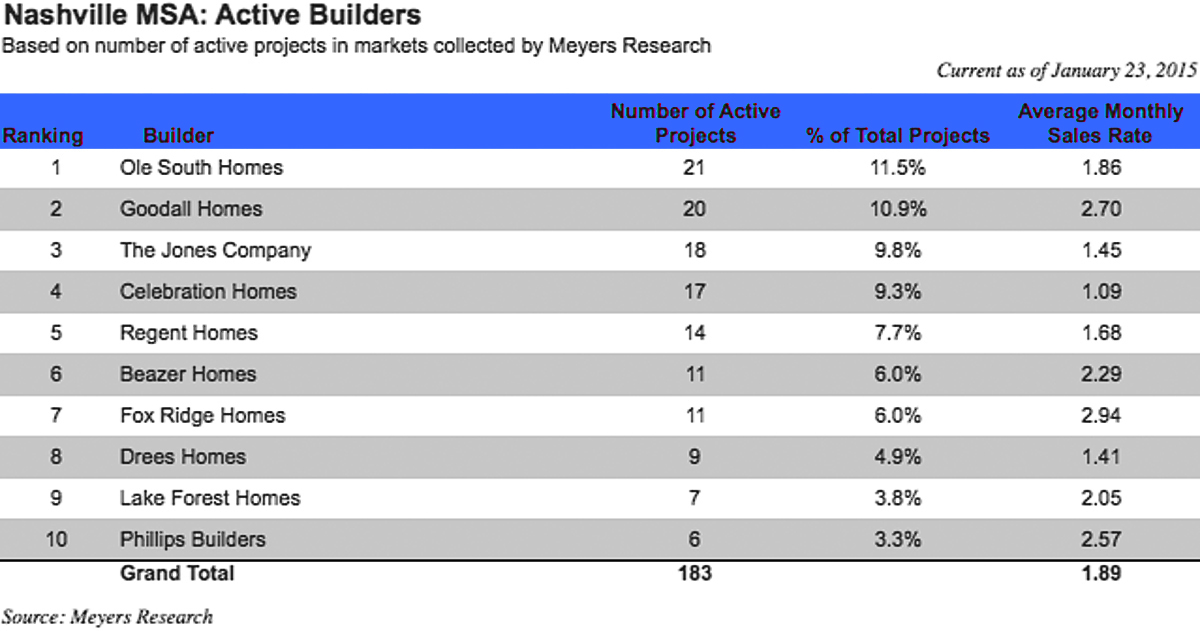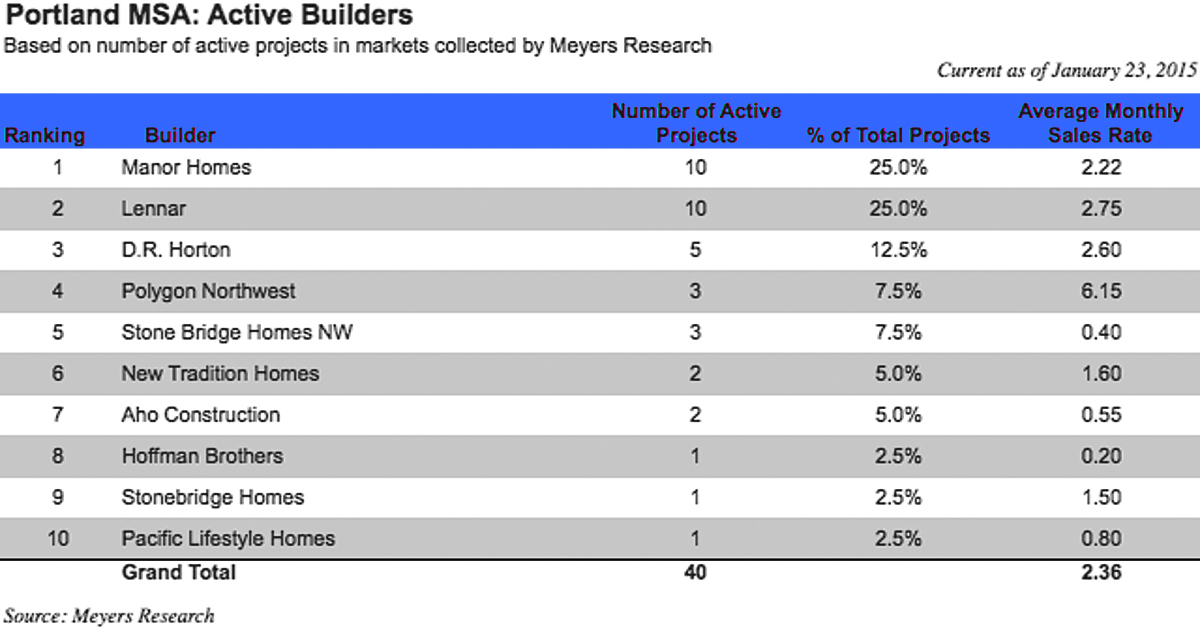News of home prices soaring skyward often focuses on metro areas that are big, hot, and densely populated. These are also places where large, public builders continue to gain market share, acquiring regionals that have strong land positions and a deeply entrenched, expert knowledge of the area. “While they’re in acquisition mode, the nationals look toward market leaders,” says Charlie Scott, a consultant to the home building industry and a contributing editor to Professional Builder. Though land is a motivating asset, Scott says, “Many of those market leaders are customer-centric home builders.” The irony of the current climate isn’t lost on Scott. “My experience is that when a giant buys one of our clients, the voice of the customer isn’t kept intact.”
While it’s true that Metropolitan Statistical Areas (MSAs) such as Houston, Phoenix, Los Angeles, and Washington, D.C., are drawing a wide range of buyers, so are metros that we hear less about, such as Detroit, Nashville, Tenn., and Portland, Ore. Or consider the Ogden-Clearfield, Utah, MSA, which is within commuting distance of Salt Lake City and home to Hill Air Force Base, Utah’s sixth largest employer. These MSAs boast jobs, a sense of place, and the sorts of lively communities that attract young homebuyers and downsizers alike.
They’re also areas where regional builders have stayed at the top of the market by leveraging the power of being local. Using data provided by Meyers Research, we took a closer look at the top companies in those metros to find out how they’re making the most of being homegrown.
View a slide show of the model homes constructed by the four builders mentioned in this story.
Ogden-Clearfield, Utah — Ivory Homes
Ivory Homes has been Utah’s No. 1 volume builder for 27 years running, and it expects this year to be its 28th, says the company’s interim CEO Dave Wolfgramm. Job growth has been fueled by Hill Air Force Base, Utah’s sixth largest employer. The base, which employs local contractors in addition to the military, attracts 80 percent first-time buyers and 20 percent move-up buyers, Wolfgramm says. Though Hill tends to be a cyclical stabilizer in slower times, when there’s a hiccup there, “it ripples through the housing industry very quickly,” Wolfgramm notes.
But in addition to boasting an active military base to stoke area growth, Ogden-Clearfield serves as a bedroom community for Salt Lake City, which is a half hour south by car or light rail. Ogden draws move-up buyers in search of a bigger, more affordable house than they’ll find in Salt Lake. “The views are just as great, and we can offer beautiful projects that are 20 to 30 percent cheaper than what you’d get in Salt Lake Valley,” says Eric Freebairn, area sales manager.
“We know this corridor very well, we’re committed to it, and we don’t build outside of it,” Wolfgramm says. “People commit to us because we’re time-tested.” Ivory prides itself on a 92 percent customer satisfaction rating (“We’ve been as high as 97 percent,” Wolfgramm adds) that results in 5 to 10 percent of buyers each month becoming repeat customers. Service before, during, and after the sale makes a potentially stressful relationship as seamless as possible, Wolfgramm observes.
Ivory prevails by having deep roots in the community and an insistence on buyers having the same (the company refuses to sell homes to flippers), as well as balanced inventory, diverse product lines, and strong land positions. “We’re glad we didn’t join the feeding frenzy in 2006 and 2007,” Wolfgramm recalls. When builders were scooping up land at high prices, Ivory pulled back. “Then the sellers came knocking at our door because the price was right, and now we’re at work.”
Detroit — Lombardo Homes
As the auto industry has rebounded, so has Detroit, now a promising place for young entrepreneurs. The under-35 population there has grown by almost 60 percent during the last 15 years, with redevelopment punting city revitalization into the national spotlight. “Michigan has had such a black cloud over it,” says Anthony Lombardo, president of Lombardo Homes. “But new businesses have found their way into our market, allowing us some independence from the auto industry.”
Detroit’s surrounding communities have long boasted good schools and an affluent population. But “it’s not just about Detroit; it’s about Michigan as a whole,” Lombardo insists. For all the negative press that Detroit has received, he says, Michigan is a beautiful place, a vacation destination, and home to excellent colleges and universities.
A private, family-owned company, Lombardo has dominated by serving first-time and move-up buyers. But even Lombardo got socked during the downturn. Rising costs in land, construction, and development made it tough to make margins. During the bust, the company was able to buy developed lots for less than replacement cost. Lombardo admits that he got overextended, but he’s also sanguine about the outcome, saying “the education, the land position, the training, the product, the limitation of home builders that came as a result were worth being over-leveraged.” Now the company is buying raw land and developing it itself in school districts where buyers want to live. Thanks to current land holdings, Anthony Lombardo says that for the next six to eight years, the company will maintain its market share. Rolling out new floor plans, elevations, and options in response to buyer feedback has also helped Lombardo stay competitive.
Nashville, Tenn. — Ole South Homes
The auto industry has helped fuel Nashville’s resurgence, too. “General Motors had all but shut down, and now it’s blowing and going,” says John Floyd, founder and owner of Ole South Homes. Factor in jobs at Vanderbilt University, as well as in the health care and music industries, and it’s no wonder that Nashville is sizzling.
In a market where margins are tight and regionals vie neck-and-neck for the top spot, Ole South maintains an edge. “It’s getting the lots on line that’s the trick,” says Floyd, of the inventory balance. “You can’t be too far out there.” He also appears to run a tight ship. “This year we will have done our 10,000th home. We’ve been in court four times in 10,000 houses. We take care of our problems,” he says. But Floyd has another leg up on the competition: He knows how to hold onto talent. Ole South offers profit-sharing and employees get a percentage check twice a year. If the nationals surpass his local company, so be it, Floyd says, using saltier language. “But you’re not going to steal my employees.”
Ole South builds houses affordable for working folks, and that’s what the company is proudest of. The Nashville suburbs are 65 percent blue collar, a market that the company dominates. Ole South can build a much nicer affordable house than it did 10 years ago, but Floyd says that when interest rates go up, some of the bells and whistles may have to go away. He knows of 10 big builders trying to get a foothold in Nashville, but says that his biggest competitors are his local brethren. “If the nationals can live with the profit margins here in middle Tennessee, they can have at it,” he says. “I’m not going to get all strung out on lots. I’d rather be third-largest and sleep well than build 1,200 houses a year and stare at the ceiling all night.”
Portland, Ore. — Manor Homes
Between the famed beauty of the Pacific Northwest, great farmers markets, esteemed colleges and universities, plus a quirky and independent spirit, Portland draws many kinds of people for all kinds of reasons. As did other metros, this one underwent hard times and has now rebounded for builders.
Manor Homes competes for Portland’s top spot with two publicly traded builders. But Manor’s owner, Randy Questad, who was born and raised in a Portland-area construction family, knows that being a hometown guy matters when it comes to serving new homebuyers. The edge that Manor maintains follows this and other precepts for maintaining market share as a regional (for more on those precepts, see
Leveraging Local). Of the competition from the nationals, Questad says, simply, “We’re way more in tune with the market.”
Manor’s sweet-spot niche is first-time move-up buyers. The company is able to be more flexible and responsive than a big builder, Questad says, because it can let buyers customize and “do whatever they want.” Later, a month after close, contact with new homeowners is initiated so that the buyer and someone from Manor can walk the house together to address any issues. This is done again at 11 months. Says Questad, “We’re as good as it gets when it comes to serving our customers and making sure they have a good buying experience.”
In such a popular place to live, keeping the land supply chain intact is one of the biggest challenges to staying on top. “I wish I had less going into the crash and picked up more after,” says Questad of land prices tripling in the current boom.
Attracting and keeping talent plays a key role in Manor maintaining its competitive edge, too. “We hire passionate people,” Questad says. “Our job supers like what they do. We give them the freedom to run their jobs, and we stay out of the way.”

Manor Homes competes for Portland’s top spot with two publicly traded builders. But Manor’s owner, Randy Questad, who was born and raised in a Portland-area construction family, knows that being a hometown guy matters when it comes to serving new homebuyers. Photo: courtesy Manor Homes
Charlie Scott, longtime housing industry consultant and a contributing editor to
Professional Builder,
foresees more acquisitions over the next few years. However, he also notes that many local builders are in a position to stay independent because of how they’ve grown post-downturn, solidifying land assets and repositioning themselves. Here’s advice from Scott on how to prevail in your market by playing to your strengths.
1. Celebrate your smallness. You’re not going to purchase better, have better software, or get better financing than a national giant. You’re a regional expert, offering great product that honors local architecture and offers an authentic sense of place. Sign on with those as your unique selling proposition.
2. Embrace your flatness. Fewer levels of hierarchy between ownership, senior leadership, and your customers offers a competitive advantage over big firms. Often, market leaders publish the owner’s name and number on the website. This sends a message about customer service and inspires confidence in potential customers.
3.
Emphasize being a local. Again, you’ve got an edge. The best local builders are much more adept than the large public companies at knowing the A and B locations, whereas
the giants often start stretching into the C and D sites. That’s fine during good times, but when the market turns, the C and D sites are the first to collapse.
4. Listen to the customer. Often, both giants and the resale market reduce home building to price per square foot. Successful market leaders know that what makes them unique is customer service, architecture, and design. Use third-party firms to gather unbiased feedback. Deliver what the customer is asking for, and offer superior follow-up.
5. Serve your community. Get involved with local charities to help enrich the community at large. Your investment resonates with residents, who aren’t just homebuyers, but are realtors, planners, and local businesspeople. In addition to doing good work, you’re creating an effective marketing tool.
6.
Hire the best. One of the smartest ways to stay competitive is making sure you have the finest superintendents,
salespeople, warranty people, and operations people. Successful builders know how to honor local talent and maintain great relationships with all the best local trades.













